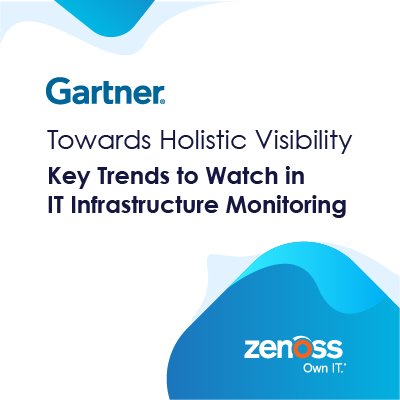
1. “The IT infrastructure monitoring (ITIM) tool market is witnessing new entrants catering to increasingly hybrid, modular, dynamic and cloud-based environments.”
If you were wondering when enterprises were going to catch up with younger IT shops and deploy the majority of their workloads to the cloud, the answer is right now. 451 Research found, in their recent Voice of the Enterprise survey, that while 44 percent of the enterprises they surveyed run most of their IT workloads using on-premises infrastructure today, only 16 percent of them expect to still be doing so two years from now. Monitoring solutions, even the ones that cater to enterprises, need to adjust to this new reality. Supporting clouds in all their forms — public, private, hybrid, hyperconverged, stratocumulus — will be essential.
2. “While there is a renewed interest in some of the new entrants, some I&O leaders are also evaluating whether investing in artificial intelligence for IT operations (AIOps) platforms can enable them to displace their existing ITIM tools.”
Gartner predicts that by 2023, 60 percent of ITIM solution purchases will factor in a desire for advanced analytics, so it’s no surprise that AIOps capabilities have become a key differentiator among vendors. At the same time, AIOps technologies are a nascent space requiring tremendous investments from IT organizations to deploy properly, in terms of both time and skills development. Still, IT practitioners look for any leverage they can get against the rising tide of machine data being generated by the environments they support.
3. “ITIM tools are helping organizations simplify and unify monitoring across domains within a single tool, eliminating the problems of multitool integration.”
Many IT architects have already lived through the explosion of server farms, virtualization, storage networks, network networks, software-defined networks, and the myriad point tools that cropped up to try to manage it all but ended up creating silos, confusion, and inefficiencies that cost the organization real money. Those architects are very eager to avoid making the same costly mistakes again. As they design new data centers to make use of emerging technologies, they’re actively looking for ways to prevent tool bloat from coming along for the ride and sapping resources.
4. “ITIM tools are allowing infrastructure and operations (I&O) leaders to scale across hybrid infrastructures and emerging architectures (such as containers and microservices).”
Containers and microservices are probably the most important delivery vehicles for ubiquitous cloud-hosted application services that we have seen, enabling applications to grow and scale with a fluidity that has never really been seen before. According to that same survey from 451 I mentioned earlier, 19 percent of enterprises are already using containers and another 18 percent of them are engaged in PoCs. As this take-up rate accelerates, the monitoring solutions these enterprises deploy need to have a native understanding of how these architectures work.
5. “Metrics and data acquired by ITIM tools are being used to derive context enabling visibility for non-IT teams (for example, line of business [LOB] and app owners) to help achieve optimization targets.”
To me, this is actually the most interesting trend. Due to the ever-increasing criticality of IT services to delivering strong business results, the health of an organization’s IT infrastructure has become more interesting to a larger cast of key stakeholders within it. As a result, executive and non-IT stakeholders are asking for help understanding how to make sense of all the operational data coming from their IT. This entails not only limiting the view of data to the most critical or interesting pieces, but surrounding those pieces with the appropriate context so a stakeholder can easily understand the business impact of whatever may be happening. As you evaluate solutions for the IT monitoring challenges in your organization, you should shortlist vendors that properly address these trends. We were honored to be included by Gartner as a representative vendor in their 2018 Market Guide for Infrastructure Monitoring Tools. Zenoss has provided infrastructure monitoring solutions to enterprises for well over a decade, and our new Zenoss Cloud SaaS offering continues the trend of offering the most capable solutions for IT monitoring as this market continues to evolve. Zenoss Cloud was rearchitected from the ground up specifically to address the five market trends outlined above:
- It includes extensions (called ZenPacks) out of the box that enable enterprises to monitor any cloud they may be using, from on-premises OpenStack and hyperconverged clouds to off-site clouds hosted in Amazon Web Services, Microsoft Azure or Google Cloud.
- Its data-streaming back end and machine learning capabilities position it well to support AIOps / analytics use cases as clients develop them.
- It boasts support for the broadest collection of enterprise infrastructure along with the deepest levels of data collection. Combined with key integrations with other ITOM tools, this enables us to provide a single interface for machine data to the entire IT organization.
- It understands containers and microservices because it was built with them, and its new architecture is specifically designed to scale in an environment where users may spin up hundreds of microservices within minutes.
- It has a thoroughly modern UI and UX that make it simple to explore metric data across any related device and any period of time and customizable dashboards that enable IT teams to show service health to key stakeholders in an easily consumable way.
If you’re interested in learning more about how Zenoss Cloud can set up your organization to be ready as IT monitoring transforms, please request a demo today. Gartner Disclaimer Gartner does not endorse any vendor, product or service depicted in its research publications, and does not advise technology users to select only those vendors with the highest ratings or other designation. Gartner research publications consist of the opinions of Gartner’s research organization and should not be construed as statements of fact. Gartner disclaims all warranties, expressed or implied, with respect to this research, including any warranties of merchantability or fitness for a particular purpose.







